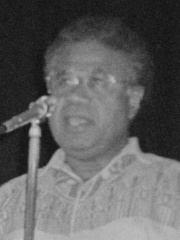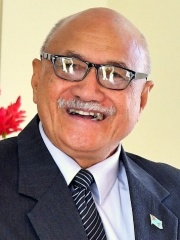
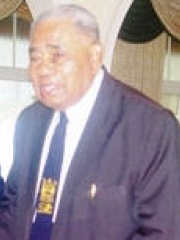
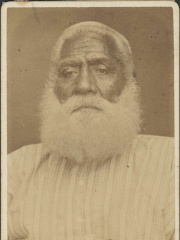
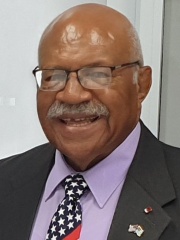
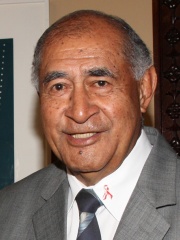
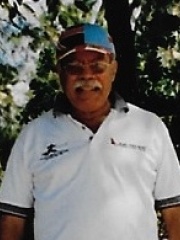
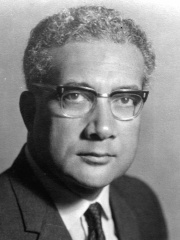
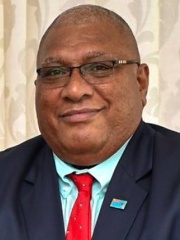
The Most Famous
POLITICIANS from Fiji
This page contains a list of the greatest Fijian Politicians. The pantheon dataset contains 19,576 Politicians, 11 of which were born in Fiji. This makes Fiji the birth place of the 149th most number of Politicians behind Oman, and Maldives.
Top 10
The following people are considered by Pantheon to be the top 10 most legendary Fijian Politicians of all time. This list of famous Fijian Politicians is sorted by HPI (Historical Popularity Index), a metric that aggregates information on a biography's online popularity. Visit the rankings page to view the entire list of Fijian Politicians.

1. Jioji Konrote (b. 1947)
With an HPI of 69.58, Jioji Konrote is the most famous Fijian Politician. Her biography has been translated into 40 different languages on wikipedia.
Major-General Jioji "George" Konousi Konrote, (born 26 December 1947) is a Fijian politician and retired Major-General of the Fiji Military who served as the President of Fiji from 2015 to 2021. After commanding a peacekeeping mission in Lebanon, Konrote served as Fiji's High Commissioner to Australia from 2001 to 2006, as Minister of State for Immigration briefly in 2006, and as Minister for Employment Opportunities, Productivity and Industrial Relations from 2014 to 2015. He was the first non-iTaukei president (as he is Rotuman), the first not to be a chief, and the first Seventh-day Adventist to be elected by parliament, as previous presidents were selected by the Great Council of Chiefs.

2. Josefa Iloilo (1920 - 2011)
With an HPI of 61.97, Josefa Iloilo is the 2nd most famous Fijian Politician. His biography has been translated into 34 different languages.
Ratu Josefa Iloilovatu Uluivuda, (29 December 1920 – 6 February 2011) was a Fijian politician who served as the 3rd President of Fiji from 2000 until 2009 following the 2000 Fijian coup d'état, excluding a brief period from 5 December 2006 to 4 January 2007 amid the 2006 coup d'état. He held the traditional title of Tui Vuda, the paramount chief of the Vuda district in Ba Province on Fiji's northwest coast. Like many Fijian people, he rarely used his surname and was known simply as Josefa Iloilo. He announced on 28 July 2009 that he would be leaving office on 30 July. At the age of 88, he was the world's oldest head of state. On 5 December 2006, Commodore Frank Bainimarama, Commander of the Republic of Fiji Military Forces and former Acting President amid the 2000 coup d'état, seized power in a new coup d'état and assumed presidential powers. This followed failed attempts on Iloilo's part to mediate a solution to the long-running impasse between the military and the government of Prime Minister Laisenia Qarase. However, his powers were restored by Bainimarama on 4 January 2007. Iloilo also endorsed Bainimarama's coup on the same day, in his first public address since the coup. He appointed Bainimarama as Prime Minister the following day. After Fiji's Court of Appeal had ruled that the removal of Prime Minister Laisenia Qarase and the appointment of Fiji's interim regime following the military coup in 2006 was unlawful, on 10 April 2009 Iloilo dismissed the judges and abrogated the country's constitution. Iloilo claimed to have the "full support" of the security forces and directed the military to take "all reasonable steps" to maintain law and order.

3. Seru Epenisa Cakobau (1815 - 1883)
With an HPI of 60.27, Seru Epenisa Cakobau is the 3rd most famous Fijian Politician. His biography has been translated into 33 different languages.
Ratu Seru Epenisa Cakobau (pronounced [ˈseru epeˈniːsa ðakomˈbau]; occasionally spelled Cacobau) (c.1815 – 1 February 1883) was a Fijian chief, monarch, and warlord (Vunivalu) who united part of Fiji's warring tribes, establishing a Fijian kingdom. He served as its only king from 1871 to 1874.

4. Sitiveni Rabuka (b. 1948)
With an HPI of 58.40, Sitiveni Rabuka is the 4th most famous Fijian Politician. His biography has been translated into 35 different languages.
Sitiveni Ligamamada Rabuka (Fijian: [sitʃiˈβeni ramˈbuka]; born 13 September 1948) is a Fijian politician, sportsman, and former soldier who has been serving as Prime Minister of Fiji since 24 December 2022. He was the instigator of two military coups in 1987. He was democratically elected as Prime Minister of Fiji, serving from 1992 to 1999, and again in 2022, leading a three-party coalition. He also served as Chairman of the Great Council of Chiefs from 1999 to 2001, and later as Chairman of the Cakaudrove Provincial Council from 2001 to 2008. Rabuka was elected as leader of the Social Democratic Liberal Party in 2016, succeeding Leader of the Opposition Ro Teimumu Kepa, who publicly disapproved of Rabuka's nomination to replace her. He was appointed as the leader of the opposition to Parliament in 2018, following the 2018 election defeat. He was the only nomination for the position, and his nomination was moved by Ro Teimumu Kepa and seconded by Biman Prasad. He was ousted as SODELPA leader by Viliame Gavoka in a leadership contest. Rabuka resigned from parliament in 2020, citing that he would no longer be an obstacle to the bipartisan approach to be taken by the leaders of Fiji to create harmony and progress, and unity in Fiji. He formed a new political party in 2020, named Peoples Alliance, to contest the 2022 election.
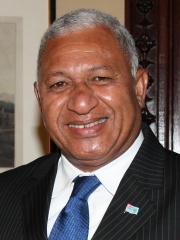
5. Frank Bainimarama (b. 1954)
With an HPI of 57.81, Frank Bainimarama is the 5th most famous Fijian Politician. His biography has been translated into 44 different languages.
Josaia Voreqe "Frank" Bainimarama (Fijian pronunciation: [tʃoˈsɛia βoˈreŋɡe mbɛiniˈmarama]; born 27 April 1954) is a Fijian former politician and naval officer who served as the prime minister of Fiji from 2007 until 2022. A member of the FijiFirst party, which he founded in 2014, he began his career as an officer in the Fijian navy and commander of the Fijian military. Despite being suspended from Parliament, he served as the opposition leader from 24 December 2022 until 8 March 2023, when he resigned and was replaced by Inia Seruiratu. Bainimarama attended Marist Brothers High School, the Asian Institute of Technology and Dalhousie University. He joined the Fijian Navy in 1975 and rose through the ranks, becoming an able seaman and a midshipman in 1976, an ensign in 1977, and later promoted to a sub-lieutenant at the end of that year. He was promoted to lieutenant-commander in 1986 and became a commander in 1988. He later became captain in 1991. In 1997, he was appointed Chief of Staff of the Republic of Fiji Military Forces. In 1998, he was promoted to a commodore and later became the commander of the Armed Forces in 1999. In 2000, during a coup attempt, he convinced the President of Fiji Kamisese Mara to resign and formed an interim military government, which negotiated with the coup leaders. The military government was replaced by a civilian one by the end of the year. He relinquished command of the military in 2014, and in recognition of his military service, he was promoted to rear admiral. Bainimarama instigated the 2006 coup, removing Prime Minister Laisenia Qarase from power. He later restored Ratu Josefa Iloilo as president and himself as prime minister in 2007. Bainimarama promised the return of elections and democracy in 2014 and formed a party named FijiFirst. In the 2014 Fijian general election, FijiFirst won a majority, and Bainimarama was sworn in as prime minister of Fiji by President Epeli Nailatikau. In the 2018 Fijian general election, FijiFirst won an outright majority, and Bainimarama became prime minister for a second term on 20 November 2018. In the 2022 Fijian general election, FijiFirst won a plurality but was unable to form a government, meaning Bainimarama ceased to be prime minister after 16 years of rule, making him the second-longest-serving prime minister of Fiji after Kamisese Mara. He was succeeded by the leader of the 1987 Fijian coups d'état, Sitiveni Rabuka. Bainimarama resigned from Parliament and as the leader of the opposition in March 2023. The next day, he was charged with abuse of office over allegations he and police commissioner Sitiveni Qiliho interfered with an investigation into financial mismanagement at the University of the South Pacific. On 14 March 2024, the High Court of Fiji convicted him of attempting to pervert the course of justice. On 9 May 2024, he was sentenced to one year in prison.

6. Epeli Nailatikau (b. 1941)
With an HPI of 56.49, Epeli Nailatikau is the 6th most famous Fijian Politician. His biography has been translated into 26 different languages.
Brigadier-General Ratu Epeli Nailatikau, (Fijian pronunciation: [epeli nailatʃikau]; born 5 July 1941) (often referred to as Na Turaga Mai Naisogolaca) is a Fijian chief who was President of Fiji from 2009 to 2015. He has had a long career in the Military, diplomatic service, and government. From 2001 to 2006 he served as Speaker of the House of Representatives – the lower and more powerful chamber of the Fijian Parliament. He was also the chairman of the Parliamentary Appropriations Committee and of the House Committee. On 8 January 2007, he was appointed the interim Minister for Foreign Affairs and External Trade; he was moved to the post of interim Minister for Provincial Development and Multi-Ethnic Affairs in September 2008. In October 2008, he became Indigenous Affairs Minister "and effectively Great Council of Chiefs chairman". On 17 April 2009, he was appointed Vice-President by the military government. On 30 July 2009, he became acting president after the retirement of President Josefa Iloilo. On 5 November 2009, he was sworn in as President of Fiji. George Konrote was elected to succeed him in October 2015. On 11 February 2019, he became the newly appointed Speaker of the Fijian Parliament, winning 30 votes against 21 to Opposition nominee and Suva lawyer, Tanya Waqanika.

7. Laisenia Qarase (1941 - 2020)
With an HPI of 56.32, Laisenia Qarase is the 7th most famous Fijian Politician. His biography has been translated into 23 different languages.
Laisenia Qarase (pronounced [lai̯seni̯a ŋɡaˈrase]; 4 February 1941 – 21 April 2020) was a Fijian politician. He served as the sixth Prime Minister of Fiji from 2000 to 2006. After the military quashed the coup that led to the removal of Mahendra Chaudhry, Qarase joined the Interim Military Government as a financial adviser on 9 June 2000, until his appointment as Prime Minister on 4 July. He won two parliamentary elections, but a military coup removed him from power on 5 December 2006. He was later imprisoned on corruption charges brought by the military-backed regime. A native of Vanua Balavu Island in the Lau archipelago, he was one of many Lauans to have held top leadership positions in Fiji.

8. Kamisese Mara (1920 - 2004)
With an HPI of 55.21, Kamisese Mara is the 8th most famous Fijian Politician. His biography has been translated into 28 different languages.
Ratu Sir Kamisese Mara, (6 May 1920 – 18 April 2004) was a Fijian politician who served as Chief Minister from 1967 to 1970, when Fiji gained its independence from the United Kingdom, and, apart from one brief interruption in 1987, as the first Prime Minister from 1970 to 1992. He subsequently served as president from 1993 to 2000.

9. Wiliame Katonivere (b. 1964)
With an HPI of 54.56, Wiliame Katonivere is the 9th most famous Fijian Politician. His biography has been translated into 28 different languages.
Ratu Wiliame Maivalili Katonivere, CF (pronounced [ɰiliame mɛiβalili katoniβere]; born 20 April 1964) is a Fijian chief and politician who served as the President of Fiji from 2021 to 2024. He has been chief of Macuata Province since 2013, succeeding his older brother Aisea Katonivere; he was previously involved in conservation initiatives of Fiji's Great Sea Reef. Katonivere has been the chairman of the Pine Group of Companies from 2020 to 2021, which includes Fiji Pine Limited, Tropik Wood Industries Limited and Tropik Wood Products Limited. He is also a board member for Fiji Airports, Fiji Sugar Corporation and Rewa Rice Ltd.
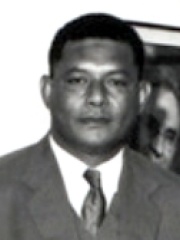
10. Penaia Ganilau (1918 - 1993)
With an HPI of 51.31, Penaia Ganilau is the 10th most famous Fijian Politician. His biography has been translated into 17 different languages.
Ratu Sir Penaia Kanatabatu Ganilau (28 July 1918 – 15 December 1993) was a Fijian politician who served as the first President of Fiji, serving from 8 December 1987 until his death in 1993. He had previously served as Governor-General of Fiji, representing Elizabeth II, Queen of Fiji, from 12 February 1983 to 15 October 1987.
People
Pantheon has 11 people classified as Fijian politicians born between 1815 and 1964. Of these 11, 5 (45.45%) of them are still alive today. The most famous living Fijian politicians include Jioji Konrote, Sitiveni Rabuka, and Frank Bainimarama. The most famous deceased Fijian politicians include Josefa Iloilo, Seru Epenisa Cakobau, and Laisenia Qarase.
Living Fijian Politicians
Go to all RankingsJioji Konrote
1947 - Present
HPI: 69.58
Sitiveni Rabuka
1948 - Present
HPI: 58.40
Frank Bainimarama
1954 - Present
HPI: 57.81
Epeli Nailatikau
1941 - Present
HPI: 56.49
Wiliame Katonivere
1964 - Present
HPI: 54.56
Deceased Fijian Politicians
Go to all RankingsJosefa Iloilo
1920 - 2011
HPI: 61.97
Seru Epenisa Cakobau
1815 - 1883
HPI: 60.27
Laisenia Qarase
1941 - 2020
HPI: 56.32
Kamisese Mara
1920 - 2004
HPI: 55.21
Penaia Ganilau
1918 - 1993
HPI: 51.31
Timoci Bavadra
1934 - 1989
HPI: 44.70
Overlapping Lives
Which Politicians were alive at the same time? This visualization shows the lifespans of the 6 most globally memorable Politicians since 1700.

